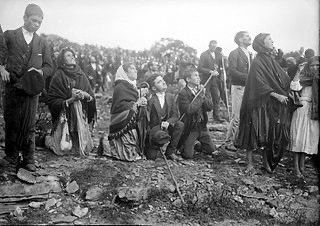Friday Links
October 13, 2023
Fatima and the Miracle of the Sun
Jonathan Geltner on Jon Fosse: What Happens to the Heart in Advent
Who Makes the Art Work? by John Skillen
Luke Coppen: ‘To be chaste is to be whole’: Bishop Varden on a neglected virtue
Mark Halliday in Literary Matters on the Bleak Solace in a Poem by William Olsen
Fatima and the Miracle of the Sun
Today is the feast of the Miracle of the Sun, which took place at Fatima in 1917. We should all pray to Our Lady of Fatima for peace, especially today. The world needs her intervention.
Jonathan Geltner on Jon Fosse: What Happens to the Heart in Advent
“This is where writers and artists start: What is going on in the sky? What do the soil and the woods and fields and streets smell like? Does the wind blow and the sea flow, and is the air cold or warm? What is there to eat and to drink? And who is here by my side? If you cannot get the weather down in a novel it is scarcely worth writing, you might as well write drama. (Fosse has written plenty of drama.) Because in northern countries like the west of Norway where Septology is set, Advent means encroaching dark and cold, everything about the earth around us and the shifting weather, though we remain sensitive to it—precisely if we are sensitive to it—serves more readily to turn one inward or dispose one to contemplation and recollection.”
Who Makes the Art Work? by John Skillen
“If and when we think about who makes the artwork, a lot of us, I suspect, will still call to mind an independent artist working alone in his or her studio on a painting or sculpture dreamed up ex nihilo, the result of purely private choices, made with no knowledge of where the artwork might end up, who will see it, whether it might make its way to a gallery, who might buy it and for what reasons, and with no input from anyone considered to have expertise in the subject matter (when one can speak of subject matter). The conditions of art-making in our time serve to maximize the artist’s freedom and room for individual expression. Artists are answerable to no one but themselves—at least that is the supposition.”
Luke Coppen: ‘To be chaste is to be whole’: Bishop Varden on a neglected virtue
Please do read Luke Coppen’s wonderful interview with Bishop Varden on his new book, Chastity: Reconciliation of the Senses. It begins on this promising answer from Bishop Varden in response to the book’s title:
“My initial idea was more ambitious: I wanted the book to be called Homo castus, to show from the outset that the semantic register of “chastity” regards more than merely attitudes to sex; that it touches a way of being human.
The editors thought a Latin title would put readers off, making the book seem too academic. Perhaps they were right. In any case, my motivation remains to show that chastity is a more interesting, generous term than people tend to assume.
In Latin Antiquity, the adjective “castus” (from which we get “chaste”) was a synonym for “integer.” To be chaste is to have integrity, to be whole. This kind of wholeness comes about in so far as I integrate those elements in me that may for whatever reason be fragmented.
Chastity is not primarily a matter of mortification; it is an aspirational virtue. In the book, I try to account for the depth and breadth of aspiration.”
Mark Halliday in Literary Matters on the Bleak Solace in a Poem by William Olsen
Halliday offers a close-read of William Olsen’s poem, “By a Railroad Crossing”:
“There are moments when each of us realizes that we are on the way to vanishing. Everything we care about will disappear from the universe. Normally we pull ourselves out of these moments and return to our lives of effort and hope. Olsen’s poem stays in its moment. From its title “By a Railroad Crossing” and phrases near the end of the poem we infer that the moment has come to the poet’s mind on a winter night, waiting in his car for a train to pass. His realization – his bleak epiphany – comes in twelve lines, six two-line stanzas.”


